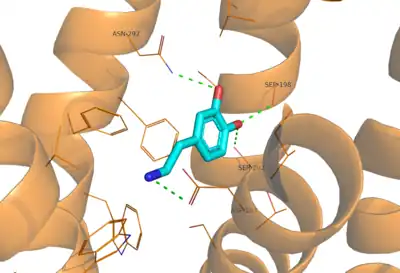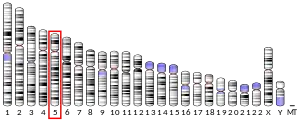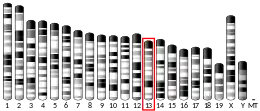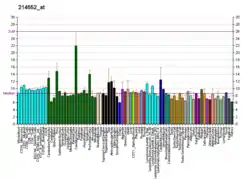Dopamine receptor D1
Dopamine receptor D1, also known as DRD1. It is one of the two types of D1-like receptor family — receptors D1 and D5. It is a protein that in humans is encoded by the DRD1 gene.[5][6][7][8]
Tissue distribution
D1 receptors are the most abundant kind of dopamine receptor in the central nervous system.
Northern blot and in situ hybridization show that the mRNA expression of DRD1 is highest in the dorsal striatum (caudate and putamen) and ventral striatum (nucleus accumbens and olfactory tubercle).[9]
Lower levels occur in the basolateral amygdala, cerebral cortex, septum, thalamus, and hypothalamus.[9]
Function
D1 receptors regulate the memory, learning, and the growth of neurons, also is used in the reward system and locomotor activity, mediating some behaviors and modulating dopamine receptor D2-mediated events.[10][8]
They play a role in addiction by facilitating the gene expression changes that occur in the nucleus accumbens during addiction.
They are Gs/a coupled and can stimulate neurons by indirectly activating cyclic AMP-dependent protein kinase.
Production
The DRD1 gene expresses primarily in the caudate putamen in humans, and in the caudate putamen, the nucleus accumbens and the olfactory tubercle in mouse. Gene expression patterns from the Allen Brain Atlases in mouse and human can be found here.
Ligands
There are a number of ligands selective for the D1 receptors. To date, most of the known ligands are based on dihydrexidine or the prototypical benzazepine partial agonist SKF-38393 (one derivative being the prototypical antagonist SCH-23390).[11] D1 receptor has a high degree of structural homology to another dopamine receptor, D5, and they both bind similar drugs.[12] As a result, none of the known orthosteric ligands is selective for the D1 vs. the D5 receptor, but the benzazepines generally are more selective for the D1 and D5 receptors versus the D2-like family.[11] Some of the benzazepines have high intrinsic activity whereas others do not. In 2015 the first positive allosteric modulator for the human D1 receptor was discovered by high-throughput screening.[13]
Agonists
Several D1 receptor agonists are used clinically. These include apomorphine, pergolide, rotigotine, and terguride. All of these drugs are preferentially D2-like receptor agonists. Fenoldopam is a selective D1 receptor partial agonist that does not cross the blood-brain-barrier and is used intravenously in the treatment of hypertension. Dihydrexidine and adrogolide (ABT-431) (a prodrug of A-86929 with improved bioavailability) are the only selective, centrally active D1-like receptor agonists that have been studied clinically in humans.[16] The selective D1 agonists give profound antiparkinson effects in humans and primate models of PD, and yield cognitive enhancement in many preclinical models and a few clinical trials. The most dose-limiting feature is profound hypotension, but the clinical development was impeded largely by lack of oral bioavailability and short duration of action.[16][17][18] In 2017, Pfizer made public information about pharmaceutically-acceptable non-catechol selective D1 agonists that are in clinical development.
List of D1 receptor agonists
- Dihydrexidine derivatives
- A-86929 – full agonist with 14-fold selectivity for D1-like receptors over D2[11][15][19]
- Dihydrexidine – full agonist with 10-fold selectivity for D1-like receptors over D2 that has been in Phase IIa clinical trials as a cognitive enhancer.[20][21] It also showed profound antiparkinson effects in MPTP-treated primates,[22] but caused profound hypotension in one early clinical trial in Parkinson's disease.[11] Although dihydrexidine has significant D2 properties, it is highly biased at D2 receptors and was used for the first demonstration of functional selectivity[23] with dopamine receptors.[24][25]
- Dinapsoline – full agonist with 5-fold selectivity for D1-like receptors over D2[11]
- Dinoxyline – full agonist with approximately equal affinity for D1-like and D2 receptors[11]
- Doxanthrine – full agonist with 168-fold selectivity for D1-like receptors over D2[11]
- Benzazepine derivatives
- SKF-81297 – 200-fold selectivity for D1 over any other receptor[11]
- SKF-82958 – 57-fold selectivity for D1 over D2[11]
- SKF-38393 – very high selectivity for D1 with negligible affinity for any other receptor[11]
- Clozapine – partial agonist at D1-like receptors[26]
- Fenoldopam – highly selective peripheral D1 receptor partial agonist used clinically as an antihypertensive[11]
- 6-Br-APB – 90-fold selectivity for D1 over D2[11]
- Others
- Stepholidine – alkaloid with D1 agonist and D2 antagonist properties, showing antipsychotic effects
- A-68930
- A-77636
- CY-208,243 – high intrinsic activity partial agonist with moderate selectivity for D1-like over D2-like receptors, member of ergoline ligand family like pergolide and bromocriptine.
- SKF-89145
- SKF-89626
- 7,8-Dihydroxy-5-phenyl-octahydrobenzo[h]isoquinoline – extremely potent, high-affinity full agonist[27]
- Cabergoline – weak D1 agonism, highly selective for D2, and various serotonin receptors
- Pergolide – (similar to cabergoline) weak D1 agonism, highly selective for D2, and various serotonin receptors
- A photoswitchable agonist of D1-like receptors (azodopa[28]) has been described that allows reversible control of dopaminergic transmission in wildtype animals.
Antagonists
Many typical and atypical antipsychotics are D1 receptor antagonists in addition to D2 receptor antagonists. But asenapine has shown stronger D1 receptor affinity compared to other antipsychotics. No other D1 receptor antagonists have been approved for clinical use. Ecopipam is a selective D1-like receptor antagonist that has been studied clinically in humans in the treatment of a variety of conditions, including schizophrenia, cocaine abuse, obesity, pathological gambling, and Tourette's syndrome, with efficacy in some of these conditions seen. The drug produced mild-to-moderate, reversible depression and anxiety in clinical studies however and has yet to complete development for any indication.
List of D1 receptor antagonists
- Benzazepine derivatives
- SCH-23,390 – 100-fold selectivity for D1 over D5[11]
- Ecopipam (SCH-39,166) – a selective D1/D5 antagonist that was being developed as an anti-obesity medication but was discontinued[11] However, it has showed promise in reducing stuttering and is currently in Phase 2 Trials for this purpose[29][30]
Protein–protein interactions
Dopamine receptor D1 has been shown to interact with:
Receptor oligomers
The D1 receptor forms heteromers with the following receptors: dopamine D2 receptor,[37] dopamine D3 receptor,[37][38] histamine H3 receptor,[39] μ opioid receptor,[40] NMDA receptor,[37] and adenosine A1 receptor.[37]
Structure
Several CryoEM structures of agonists bound to the dopamine D1 receptor complexed with the stimulatory heterotrimeric Gs protein have been determined. Agonist interact with extracellular loop 2 and extracellular regions of trans-membrane helices 2, 3, 6, and 7. Interactions between catechol-based agonists and three trans-membrane serine residues including S1985.42, S1995.43, and S2025.46 function as microswitches that are essential for receptor activation.[42]

See also
References
- GRCh38: Ensembl release 89: ENSG00000184845 - Ensembl, May 2017
- GRCm38: Ensembl release 89: ENSMUSG00000021478 - Ensembl, May 2017
- "Human PubMed Reference:". National Center for Biotechnology Information, U.S. National Library of Medicine.
- "Mouse PubMed Reference:". National Center for Biotechnology Information, U.S. National Library of Medicine.
- Dearry A, Gingrich JA, Falardeau P, Fremeau RT, Bates MD, Caron MG (September 1990). "Molecular cloning and expression of the gene for a human D1 dopamine receptor". Nature. 347 (6288): 72–76. Bibcode:1990Natur.347...72D. doi:10.1038/347072a0. PMID 2144334. S2CID 4281682.
- Zhou QY, Grandy DK, Thambi L, Kushner JA, Van Tol HH, Cone R, et al. (September 1990). "Cloning and expression of human and rat D1 dopamine receptors". Nature. 347 (6288): 76–80. Bibcode:1990Natur.347...76Z. doi:10.1038/347076a0. PMID 2168520. S2CID 4313577.
- Sunahara RK, Niznik HB, Weiner DM, Stormann TM, Brann MR, Kennedy JL, et al. (September 1990). "Human dopamine D1 receptor encoded by an intronless gene on chromosome 5". Nature. 347 (6288): 80–83. Bibcode:1990Natur.347...80S. doi:10.1038/347080a0. PMID 1975640. S2CID 4236625.
- Mishra A, Singh S, Shukla S (2018-05-31). "Physiological and Functional Basis of Dopamine Receptors and Their Role in Neurogenesis: Possible Implication for Parkinson's disease". Journal of Experimental Neuroscience. 12: 1179069518779829. doi:10.1177/1179069518779829. PMC 5985548. PMID 29899667.
- Schetz JA, Sibley DR (2007). "Chapter 7: Dopaminergic Neurotransmission". In Sibley DR (ed.). Handbook of Contemporary Neuropharmacology. Hoboken, NJ: Wiley-Interscience. p. 226. ISBN 9780471660538.
Localization of the D1 receptor messenger ribonucleic acid (mRNA) expression has been mapped using Northern analysis and in situ hybridization (for a review, see [54]). Expression of D1 receptor mRNA is highest in the caudate putamen, nucleus accumbens, and olfactory tubercle. Lower levels of expression are found in the basolateral amygdala, cerebral cortex, septum pellucidum, thalamus, and hypothalamus.
- Paul ML, Graybiel AM, David JC, Robertson HA (October 1992). "D1-like and D2-like dopamine receptors synergistically activate rotation and c-fos expression in the dopamine-depleted striatum in a rat model of Parkinson's disease". The Journal of Neuroscience. 12 (10): 3729–3742. doi:10.1523/JNEUROSCI.12-10-03729.1992. PMC 6575976. PMID 1357113.
- Zhang J, Xiong B, Zhen X, Zhang A (March 2009). "Dopamine D1 receptor ligands: where are we now and where are we going". Medicinal Research Reviews. 29 (2): 272–294. doi:10.1002/med.20130. PMID 18642350. S2CID 25334596.
- Sunahara RK, Guan HC, O'Dowd BF, Seeman P, Laurier LG, Ng G, et al. (April 1991). "Cloning of the gene for a human dopamine D5 receptor with higher affinity for dopamine than D1". Nature. 350 (6319): 614–619. Bibcode:1991Natur.350..614S. doi:10.1038/350614a0. PMID 1826762. S2CID 4373022.
- Lewis MA, Hunihan L, Watson J, Gentles RG, Hu S, Huang Y, et al. (September 2015). "Discovery of D1 Dopamine Receptor Positive Allosteric Modulators: Characterization of Pharmacology and Identification of Residues that Regulate Species Selectivity". The Journal of Pharmacology and Experimental Therapeutics. 354 (3): 340–349. doi:10.1124/jpet.115.224071. PMID 26109678.
- Cueva JP, Giorgioni G, Grubbs RA, Chemel BR, Watts VJ, Nichols DE (November 2006). "trans-2,3-dihydroxy-6a,7,8,12b-tetrahydro-6H-chromeno[3,4-c]isoquinoline: synthesis, resolution, and preliminary pharmacological characterization of a new dopamine D1 receptor full agonist". Journal of Medicinal Chemistry. 49 (23): 6848–6857. doi:10.1021/jm0604979. PMID 17154515.
- Michaelides MR, Hong Y, DiDomenico S, Asin KE, Britton DR, Lin CW, et al. (September 1995). "(5aR,11bS)-4,5,5a,6,7,11b-hexahydro-2-propyl-3-thia-5-azacyclopent-1- ena[c]-phenanthrene-9,10-diol (A-86929): a potent and selective dopamine D1 agonist that maintains behavioral efficacy following repeated administration and characterization of its diacetyl prodrug (ABT-431)". Journal of Medicinal Chemistry. 38 (18): 3445–3447. doi:10.1021/jm00018a002. PMID 7658429.
- Rosell DR, Zaluda LC, McClure MM, Perez-Rodriguez MM, Strike KS, Barch DM, et al. (January 2015). "Effects of the D1 dopamine receptor agonist dihydrexidine (DAR-0100A) on working memory in schizotypal personality disorder". Neuropsychopharmacology. 40 (2): 446–453. doi:10.1038/npp.2014.192. PMC 4443959. PMID 25074637.
- Blanchet PJ, Fang J, Gillespie M, Sabounjian L, Locke KW, Gammans R, et al. (1998). "Effects of the full dopamine D1 receptor agonist dihydrexidine in Parkinson's disease". Clinical Neuropharmacology. 21 (6): 339–343. PMID 9844789.
- Giardina WJ, Williams M (2006). "Adrogolide HCl (ABT-431; DAS-431), a prodrug of the dopamine D1 receptor agonist, A-86929: preclinical pharmacology and clinical data". CNS Drug Reviews. 7 (3): 305–316. doi:10.1111/j.1527-3458.2001.tb00201.x. PMC 6741696. PMID 11607045.
- Yamashita M, Yamada K, Tomioka K (February 2004). "Construction of arene-fused-piperidine motifs by asymmetric addition of 2-trityloxymethylaryllithiums to nitroalkenes: the asymmetric synthesis of a dopamine D1 full agonist, A-86929". Journal of the American Chemical Society. 126 (7): 1954–1955. doi:10.1021/ja031760n. PMID 14971926.
- Mu Q, Johnson K, Morgan PS, Grenesko EL, Molnar CE, Anderson B, et al. (August 2007). "A single 20 mg dose of the full D1 dopamine agonist dihydrexidine (DAR-0100) increases prefrontal perfusion in schizophrenia". Schizophrenia Research. 94 (1–3): 332–341. doi:10.1016/j.schres.2007.03.033. PMID 17596915. S2CID 25497605.
- George MS, Molnar CE, Grenesko EL, Anderson B, Mu Q, Johnson K, et al. (July 2007). "A single 20 mg dose of dihydrexidine (DAR-0100), a full dopamine D1 agonist, is safe and tolerated in patients with schizophrenia". Schizophrenia Research. 93 (1–3): 42–50. doi:10.1016/j.schres.2007.03.011. PMID 17467956. S2CID 31375175.
- Taylor JR, Lawrence MS, Redmond DE, Elsworth JD, Roth RH, Nichols DE, Mailman RB (July 1991). "Dihydrexidine, a full dopamine D1 agonist, reduces MPTP-induced parkinsonism in monkeys". European Journal of Pharmacology. 199 (3): 389–391. doi:10.1016/0014-2999(91)90508-N. PMID 1680717.
- Urban JD, Clarke WP, von Zastrow M, Nichols DE, Kobilka B, Weinstein H, et al. (January 2007). "Functional selectivity and classical concepts of quantitative pharmacology". The Journal of Pharmacology and Experimental Therapeutics. 320 (1): 1–13. doi:10.1124/jpet.106.104463. PMID 16803859. S2CID 447937.
- Mottola DM, Kilts JD, Lewis MM, Connery HS, Walker QD, Jones SR, et al. (June 2002). "Functional selectivity of dopamine receptor agonists. I. Selective activation of postsynaptic dopamine D2 receptors linked to adenylate cyclase". The Journal of Pharmacology and Experimental Therapeutics. 301 (3): 1166–1178. doi:10.1124/jpet.301.3.1166. PMID 12023552. S2CID 2858428.
- Kilts JD, Connery HS, Arrington EG, Lewis MM, Lawler CP, Oxford GS, et al. (June 2002). "Functional selectivity of dopamine receptor agonists. II. Actions of dihydrexidine in D2L receptor-transfected MN9D cells and pituitary lactotrophs". The Journal of Pharmacology and Experimental Therapeutics. 301 (3): 1179–1189. doi:10.1124/jpet.301.3.1179. PMID 12023553.
- Ahlenius S (May 1999). "Clozapine: dopamine D1 receptor agonism in the prefrontal cortex as the code to decipher a Rosetta stone of antipsychotic drugs". Pharmacology & Toxicology. 84 (5): 193–196. doi:10.1111/j.1600-0773.1999.tb01482.x. PMID 10361974.
- Bonner LA, Chemel BR, Watts VJ, Nichols DE (September 2010). "Facile synthesis of octahydrobenzo[h]isoquinolines: novel and highly potent D1 dopamine agonists". Bioorganic & Medicinal Chemistry. 18 (18): 6763–6770. doi:10.1016/j.bmc.2010.07.052. PMC 2941879. PMID 20709559.
- Matera C, Calvé P, Casadó-Anguera V, Sortino R, Gomila AM, Moreno E, et al. (January 2022). "Reversible Photocontrol of Dopaminergic Transmission in Wild-Type Animals". International Journal of Molecular Sciences. 23 (17): 10114. doi:10.3390/ijms231710114. ISSN 1422-0067. PMC 9456102. PMID 36077512.
- Maguire, G. A.; Lasalle, L.; Hoffmeyer, D.; Nelson, M.; Lochhead, J. D.; Davis, K.; Burris, A.; Yaruss, J. S. (2019). "Ecopipam as a pharmacologic treatment of stuttering". Annals of Clinical Psychiatry. 31 (3): 164–168. PMID 31369655.
- "First Patient Dosed in Emalex Biosciences Phase 2 Clinical Trial for Stuttering - Emalex Biosciences".
- Svensson KA, Heinz BA, Schaus JM, Beck JP, Hao J, Krushinski JH, et al. (January 2017). "An Allosteric Potentiator of the Dopamine D1 Receptor Increases Locomotor Activity in Human D1 Knock-In Mice without Causing Stereotypy or Tachyphylaxis". The Journal of Pharmacology and Experimental Therapeutics. 360 (1): 117–128. doi:10.1124/jpet.116.236372. PMC 5193077. PMID 27811173.
- Bruns RF, Mitchell SN, Wafford KA, Harper AJ, Shanks EA, Carter G, et al. (January 2018). "Preclinical profile of a dopamine D1 potentiator suggests therapeutic utility in neurological and psychiatric disorders". Neuropharmacology. 128: 351–365. doi:10.1016/j.neuropharm.2017.10.032. PMID 29102759.
- Wang X, Heinz BA, Qian YW, Carter JH, Gadski RA, Beavers LS, et al. (October 2018). "Intracellular Binding Site for a Positive Allosteric Modulator of the Dopamine D1 Receptor". Molecular Pharmacology. 94 (4): 1232–1245. doi:10.1124/mol.118.112649. PMID 30111649.
- Hao J, Beck JP, Schaus JM, Krushinski JH, Chen Q, Beadle CD, et al. (October 2019). "Synthesis and Pharmacological Characterization of 2-(2,6-Dichlorophenyl)-1-((1S,3R)-5-(3-hydroxy-3-methylbutyl)-3-(hydroxymethyl)-1-methyl-3,4-dihydroisoquinolin-2(1H)-yl)ethan-1-one (LY3154207), a Potent, Subtype Selective, and Orally Available Positive Allosteric Modulator of the Human Dopamine D1 Receptor". Journal of Medicinal Chemistry. 62 (19): 8711–8732. doi:10.1021/acs.jmedchem.9b01234. PMID 31532644.
- Bermak JC, Li M, Bullock C, Weingarten P, Zhou QY (February 2002). "Interaction of gamma-COP with a transport motif in the D1 receptor C-terminus". European Journal of Cell Biology. 81 (2): 77–85. doi:10.1078/0171-9335-00222. PMID 11893085.
- Bermak JC, Li M, Bullock C, Zhou QY (May 2001). "Regulation of transport of the dopamine D1 receptor by a new membrane-associated ER protein". Nature Cell Biology. 3 (5): 492–498. doi:10.1038/35074561. PMID 11331877. S2CID 40809366.
- Nishi A, Kuroiwa M, Shuto T (July 2011). "Mechanisms for the modulation of dopamine d(1) receptor signaling in striatal neurons". Frontiers in Neuroanatomy. 5: 43. doi:10.3389/fnana.2011.00043. PMC 3140648. PMID 21811441.
Dopamine D1 receptor hetero-oligomers - Marcellino D, Ferré S, Casadó V, Cortés A, Le Foll B, Mazzola C, et al. (September 2008). "Identification of dopamine D1-D3 receptor heteromers. Indications for a role of synergistic D1-D3 receptor interactions in the striatum". The Journal of Biological Chemistry. 283 (38): 26016–26025. doi:10.1074/jbc.M710349200. PMC 2533781. PMID 18644790.
- Ferrada C, Moreno E, Casadó V, Bongers G, Cortés A, Mallol J, et al. (May 2009). "Marked changes in signal transduction upon heteromerization of dopamine D1 and histamine H3 receptors". British Journal of Pharmacology. 157 (1): 64–75. doi:10.1111/j.1476-5381.2009.00152.x. PMC 2697789. PMID 19413572.
- Juhasz JR, Hasbi A, Rashid AJ, So CH, George SR, O'Dowd BF (March 2008). "Mu-opioid receptor heterooligomer formation with the dopamine D1 receptor as directly visualized in living cells". European Journal of Pharmacology. 581 (3): 235–243. doi:10.1016/j.ejphar.2007.11.060. PMID 18237729.
- Rodríguez-Ruiz M, Moreno E, Moreno-Delgado D, Navarro G, Mallol J, Cortés A, et al. (August 2017). "Heteroreceptor Complexes Formed by Dopamine D1, Histamine H3, and N-Methyl-D-Aspartate Glutamate Receptors as Targets to Prevent Neuronal Death in Alzheimer's Disease" (PDF). Molecular Neurobiology. 54 (6): 4537–4550. doi:10.1007/s12035-016-9995-y. PMID 27370794. S2CID 11203108.
- Sibley DR, Luderman KD, Free RB, Shi L (May 2021). "Novel Cryo-EM structures of the D1 dopamine receptor unlock its therapeutic potential". Signal Transduction and Targeted Therapy. 6 (1): 205. doi:10.1038/s41392-021-00630-3. PMC 8141052. PMID 34023856.
- Zhuang Y, Krumm B, Zhang H, Zhou XE, Wang Y, Huang XP, et al. (May 2021). "Mechanism of dopamine binding and allosteric modulation of the human D1 dopamine receptor". Cell Research. 31 (5): 593–596. doi:10.1038/s41422-021-00482-0. PMC 8089099. PMID 33750903.
External links
- "Dopamine Receptors: D1". IUPHAR Database of Receptors and Ion Channels. International Union of Basic and Clinical Pharmacology.
- Receptors,+Dopamine+D1 at the U.S. National Library of Medicine Medical Subject Headings (MeSH)
This article incorporates text from the United States National Library of Medicine, which is in the public domain.





